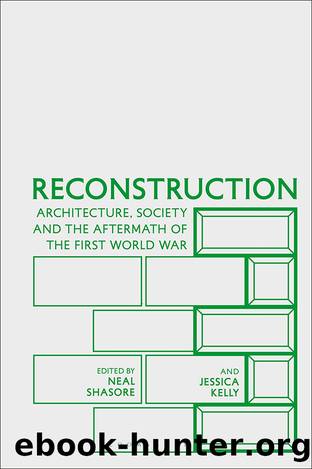Reconstruction by Neal Shasore;Jessica Kelly;

Author:Neal Shasore;Jessica Kelly;
Language: eng
Format: epub
Publisher: Bloomsbury UK
Figure 7.1 St Michael, Mill Hill. Drawing of W. D. Caröeâs original design, Consecration Leaflet (1922): 17, Lambeth Palace Library, ICBS_11395 St Michael Mill Hill
Despite the redistribution of power in favour of the PCC, it is clear that having an architect open to discussion and negotiation on designs for new churches was essential if a congregation was intent on full engagement. Without these conditions, difficulties arose that were to persist for a surprisingly long time. At St Barnabas, Temple Fortune in London, the finances were an issue but so was the inability of the architects to forge a working relationship with a PCC keen to be involved in design decisions, resulting in a similar catalogue of delays to Mill Hill and to false starts. The involvement of the congregation caused considerable consternation to their first architect, Maurice Webb.41 Despite having capable and experienced members, the PCCâs approach lacked clarity and would have benefitted from a fully interactive relationship with the architect. The Building Committee members were meticulous in their research but were indiscriminate in informing Webb of all their ideas, many before they were properly formed. Webb did not once visit the PCC to discuss the detail with them nor did he appear to grasp the difficult financial situation in the parish or the restrictions under which he was working.42 This led to no fewer than six complete redesigns from the initial instruction for a church âon Byzantine linesâ through to a final simple Gothic design that failed to win the approval of the London Dioceseâs Honorary Advisory Committee Architects.43 This rejection, coupled with the lack of interaction with the parish in order to understand their requirements, led ultimately to his resignation.44 In contrast to Webb, the parishâs chosen replacement architect, Ernest Shearman, attended PCC meetings and gave the impression of considering the proposals put to him by the Building Committee.45 But it is clear from the frustrated exchanges between the committee and the architect that he was inclined to ignore their input.46 This constant miscommunication was one of the factors contributing to the building remaining unfinished at the outbreak of the Second World War (Figure 7.2).
Download
This site does not store any files on its server. We only index and link to content provided by other sites. Please contact the content providers to delete copyright contents if any and email us, we'll remove relevant links or contents immediately.
Kathy Andrews Collection by Kathy Andrews(11323)
The remains of the day by Kazuo Ishiguro(8394)
Paper Towns by Green John(4798)
Spare by Prince Harry The Duke of Sussex(4787)
Industrial Automation from Scratch: A hands-on guide to using sensors, actuators, PLCs, HMIs, and SCADA to automate industrial processes by Olushola Akande(4599)
The Body: A Guide for Occupants by Bill Bryson(4583)
Be in a Treehouse by Pete Nelson(3647)
Machine Learning at Scale with H2O by Gregory Keys | David Whiting(3623)
Harry Potter and the Goblet Of Fire by J.K. Rowling(3608)
Never by Ken Follett(3526)
Goodbye Paradise(3446)
The Remains of the Day by Kazuo Ishiguro(3138)
Into Thin Air by Jon Krakauer(3131)
The Cellar by Natasha Preston(3077)
The Genius of Japanese Carpentry by Azby Brown(3038)
Fairy Tale by Stephen King(2948)
120 Days of Sodom by Marquis de Sade(2939)
Drawing Shortcuts: Developing Quick Drawing Skills Using Today's Technology by Leggitt Jim(2939)
The Man Who Died Twice by Richard Osman(2807)
